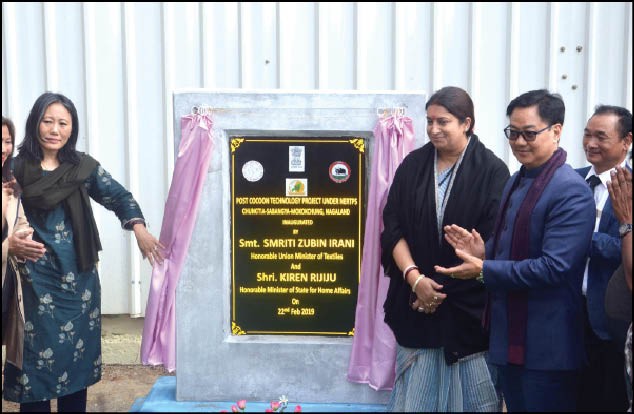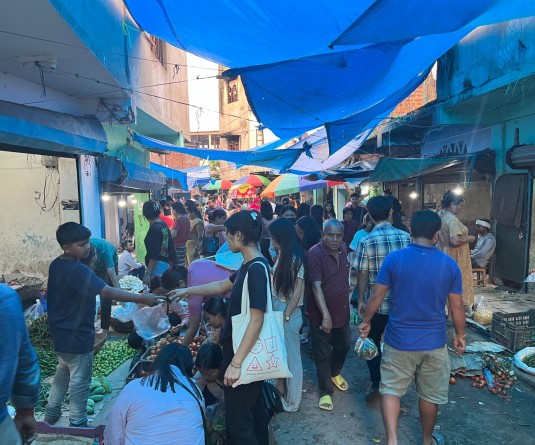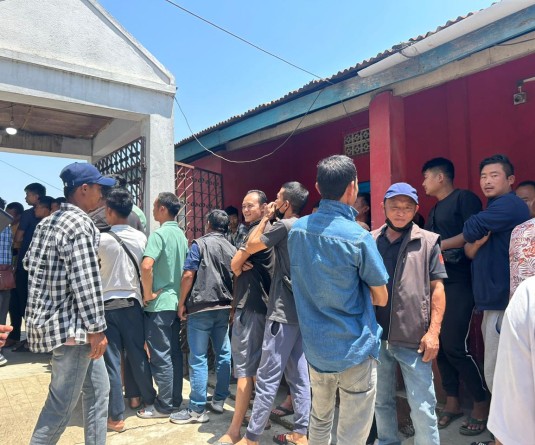Union Minister of Textiles, Smriti Zubin Irani and Minister of State for Home Affairs, Kiren Rijiju jointly inaugurating the Post Cocoon Technology Project at Sabangya, Chungtia village, Mokokchung on Friday. (Morung Photo)

Morung Express News
Mokokchung | February 22
Union Minister of Textiles, Smriti Zubin Irani and Minister of State for Home Affairs, Kiren Rijiju jointly inaugurated a Post Cocoon Technology Project today at Sabangya, Chungtia village, Mokokchung under the North East Region Textile Promotion Scheme (NERTPS) of the Ministry of Textile, Government of India.
Located about 15 kilometers from Mokokchung town along NH702D, the project inaugurated today at Sabangya, Chungtia includes a dyeing unit, a twisting unit and two common facility centers with fifty weaving looms in each center.
Another infrastructure located at Kobulong, Mokokchung was also formally inaugurated today by the ministers, the inaugural plaque of which was jointly unveiled by Irani and Rijiju. They also formally launched another two new projects under NERTPS to be implemented at Kiphire and Wokha.
Union Minister of Textiles, Smriti Zubin Irani while speaking at the inaugural of the Post Cocoon Technology Project at Sabangya, Chungtia today said that the government has initiated several projects in regard to the silk sector in the NE India region, including Nagaland.
Saying that sericulture in the region has transformed from a tribal craft to an industry of immense potential providing livelihood opportunity to the rural poor, she remarked that the NE region has the distinction of being the only region producing four varieties of silk – mulberry, oak tasar, muga and eri.
The NE contributes almost 100% of the country’s muga and oak tasar silk and 99% of eri silk production of the country, she informed. She also stated that her ministry was dedicated to the cause of developing Nagaland and NE India region and added that apart from the silk sector, the government will also provide tool kits free of cost to registered artisans of the region to promote handicraft industry. Responding to a representation submitted to her by the Chungtia village council for an eri silk project, Irani assured the village that the proposal would be approved and that the Central Silk Board will be instructed to prepare a detailed project report for the same.
Minister of State for Home Affairs, Kiren Rijiju who accompanied the Textiles minister from Itanagar, where similar projects under NERTPS were also inaugurated and launched, said Nagas were naturally gifted in fashion and designing and that sericulture was one sector where Nagas can stand out from the rest of the country.
He also described that the various schemes under the Ministry of Textiles will not only create employment generation but also promote women empowerment. “Nagaland’s issues are well known to me and are close to my heart,” he said, and added that he was committed to developing Nagaland and NE India.
The Muga P3 Basic Seed Production Centre at Kobulong, Mokokchung inaugurated today is one of the three such centers approved under NERTPS, the other two being in Assam. The basic seed center at Kobulong was approved by the ministry’s Project Approval and Monitoring Committee (PAMC) in March, 2015 and had sanctioned an amount of Rs. 3. 17 crore for the Kobulong project. The project was implemented by the Central Silk Board and was sponsored 100% by the central ministry.
The other two new projects launched today included an “Integrated Scheme for Development of Eri and Oak Tasar Silk Industry in Aspirational District, Kiphire” and a “Bivoltine Sericulture Development Project for Women Empowerment” at Wokha district.




